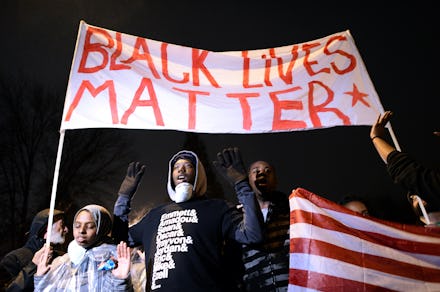Rudy Giuliani Perpetuates a Dangerous Myth About Black Crime in America

The news: Onetime New York City mayor and presidential hopeful Rudy Giuliani has a message for the protesters in Ferguson, Missouri: "Why don't you cut it down so that so many white police officers don't have to be in black areas?"
On Sunday, Giuliani had a heated debate on Meet the Press with Georgetown professor Michael Eric Dyson over the issue of overwhelmingly white police forces in predominantly black communities. But while Giuliani argued that he spent his mayorship diversifying the NYPD, he also made a controversial point that has often been used in the wake of Michael Brown's shooting: The real issue at hand is not racial discrimination and police brutality, but black-on-black crime.
"Ninety-three percent of blacks are killed by other blacks," Giuliani said in the interview. "I would like to see the attention paid to that that you are paying to this."
"What about the poor black child that was killed by another black child? Why aren't you protesting that?" Giuliani added, telling Dyson, who happens to be black. "White police officers wouldn't be there if you weren't killing each other."
This is, as Dyson points out, a "false equivalency." The statistic that Giuliani quotes comes from a 2008 Justice Department report. And though the 93% figure is accurate in describing the prevalence of black-on-black crime, it overlooks the fact that white-on-white crime is nearly as rampant: The same report found that 84% of white victims are killed by white assailants.
What this report shows more than anything is that most murders are intraracial, and that a certain race is no more predisposed toward violence than others. While the high murder counts in areas like Chicago are certainly concerning and deserve to be reported, it makes little sense to blame a community instead of examining the underlying factors that contribute to this trend.
In the meantime, there are real issues at hand. As a Washington Post analysis found, and as Giuliani declined to accept in Sunday's interview, the majority of large U.S. cities have predominantly white police departments; in Ferguson, only 3 of 53 police officers are black, despite the fact that two-thirds of the community is black. And that's not taking into account the confluence of sociocultural issues and decades of discriminatory housing policies that led to entrenched poverty and systemic repression in these communities.
As Vox's Lauren Williams points out, "Black and Latino children are more likely to attend schools that are segregated by both race and income. White families are about six times more wealthy than black families. Just 43.5% of black Americans own homes, about 20 percentage points below the national rate. The African-American poverty rate is 27.2%, while the white poverty rate is 9.7%. In July, national unemployment was at 6.2%, but for black people, it was 11.4%."
The fact of the matter is, there are deeply concerning issues in predominantly black communities, from poverty and unemployment to, yes, black-on-black crime. But to simply blame an entire population instead of examining where this problem comes from is not only irresponsible and dismissive, it's an ugly reminder that racism is still coloring the way we view "black" issues.